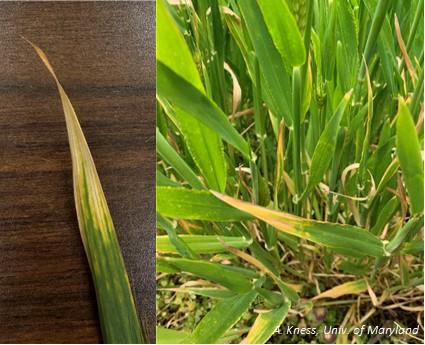
Figure 1. Wheat leaves with symptoms of leaf tip necrosis. Note the dead tissue at the leaf tips. Photo: A. Kness, University of Maryland
Wheat Leaf Tip Necrosis Showing in Many Wheat Fields

Over the past couple of weeks we have gotten several questions about yellowing flag leaves on wheat. Generally these symptoms are appearing widespread in fields. To the best of our knowledge we can attribute this to leaf burn or leaf tip necrosis (LTN) (Figure 1). This disorder is often a response to cold injury or wind, but can also manifest as a result of heat and drought stress. We have had widespread hot and dry conditions for several weeks across Maryland, which can trigger these symptoms, especially on lighter soils. These symptoms can also be intensified by specific leaf rust and stripe rust resistance genes and LTN severity can vary greatly between varieties. In any case, there is nothing you can do to remedy the situation.
Leaf tip necrosis may be confused with barley yellow dwarf virus (BYDV). BYDV is undoubtedly contributing to some of the symptoms in many of these fields, but it is probably not the sole factor causing these symptoms. LTN tends to cause death of the leaf tip resulting in necrotic brown tissue (Figure 1), whereas BYDV can cause a range of symptoms from yellowing of the leaf, which may or may not be accompanied with bronzing/purpling of the leaf tips (Figure 2). Notably with BYD, leaf tips do not die and become necrotic; whereas leaf tissue from LTN will become brown and dead starting at the leaf margins near the tip and work inward. Since BYDV is vectored by aphids, symptoms tend to be localized in hotspots in a field where aphids populations are high, whereas leaf burn and LTN more uniformly affect the entire field.
This article appears in May 2024, Volume 15, Issue 2 of the Agronomy News.
Agronomy News, May 2024, Vol. 15, Issue 2
Agronomy News is a statewide newsletter for farmers, consultants, researchers, and educators interested in grain and row crop forage production systems. This newsletter is published once a month during the growing season and will include topics pertinent to agronomic crop production. Subscribers will receive an email with the latest edition.
Subscribe
 English
English العربية
العربية Български
Български 简体中文
简体中文 繁體中文
繁體中文 Hrvatski
Hrvatski Čeština
Čeština Dansk
Dansk Nederlands
Nederlands Suomi
Suomi Français
Français Deutsch
Deutsch Ελληνικά
Ελληνικά हिन्दी
हिन्दी Italiano
Italiano 日本語
日本語 한국어
한국어 Norsk bokmål
Norsk bokmål Polski
Polski Português
Português Română
Română Русский
Русский Español
Español Svenska
Svenska Català
Català Filipino
Filipino עִבְרִית
עִבְרִית Bahasa Indonesia
Bahasa Indonesia Latviešu valoda
Latviešu valoda Lietuvių kalba
Lietuvių kalba Српски језик
Српски језик Slovenčina
Slovenčina Slovenščina
Slovenščina Українська
Українська Tiếng Việt
Tiếng Việt Shqip
Shqip Eesti
Eesti Galego
Galego Magyar
Magyar Maltese
Maltese ไทย
ไทย Türkçe
Türkçe فارسی
فارسی Afrikaans
Afrikaans Bahasa Melayu
Bahasa Melayu Kiswahili
Kiswahili Gaeilge
Gaeilge Cymraeg
Cymraeg Беларуская мова
Беларуская мова Íslenska
Íslenska Македонски јазик
Македонски јазик יידיש
יידיש Հայերեն
Հայերեն Azərbaycan dili
Azərbaycan dili Euskara
Euskara ქართული
ქართული Kreyol ayisyen
Kreyol ayisyen اردو
اردو বাংলা
বাংলা Bosanski
Bosanski Cebuano
Cebuano Esperanto
Esperanto ગુજરાતી
ગુજરાતી Harshen Hausa
Harshen Hausa Hmong
Hmong Igbo
Igbo Basa Jawa
Basa Jawa ಕನ್ನಡ
ಕನ್ನಡ ភាសាខ្មែរ
ភាសាខ្មែរ ພາສາລາວ
ພາສາລາວ Latin
Latin Te Reo Māori
Te Reo Māori मराठी
मराठी Монгол
Монгол नेपाली
नेपाली ਪੰਜਾਬੀ
ਪੰਜਾਬੀ Afsoomaali
Afsoomaali தமிழ்
தமிழ் తెలుగు
తెలుగు Yorùbá
Yorùbá Zulu
Zulu ဗမာစာ
ဗမာစာ Chichewa
Chichewa Қазақ тілі
Қазақ тілі Malagasy
Malagasy മലയാളം
മലയാളം සිංහල
සිංහල Sesotho
Sesotho Basa Sunda
Basa Sunda Тоҷикӣ
Тоҷикӣ O‘zbekcha
O‘zbekcha አማርኛ
አማርኛ Corsu
Corsu Ōlelo Hawaiʻi
Ōlelo Hawaiʻi كوردی
كوردی Кыргызча
Кыргызча Lëtzebuergesch
Lëtzebuergesch پښتو
پښتو Samoan
Samoan Gàidhlig
Gàidhlig Shona
Shona سنڌي
سنڌي Frysk
Frysk isiXhosa
isiXhosa